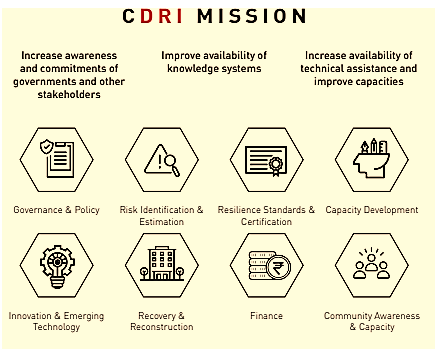UN Climate Action Summit-2019
- 24 Sep 2019
- On 23rd September, 2019, United Nation (UN) Secretary-General Antonio Guterres convened the Climate Action Summit in New York, to ramp up climate actions worldwide at the highest levels that will enable implementation of many of the goals of the 2030 Agenda for Sustainable Development.
Objective
- To boost ambition and accelerate actions to implement the Paris Agreement on Climate Change.
Rising Concerns
- Global emissions are reaching record levels.The last four years were the four hottest on record, and winter temperatures in the Arctic have risen by 3°C since 1990.
- Sea levels are rising; coral reefs are dying with the life-threatening impact of climate change on health, through air pollution, heatwaves and risks to food security.
- The impacts of climate change are being felt everywhere and are having very real consequences on people’s lives.
Key Highlights of the Summit
- The Summit focused on to develop ambitious solutions in six areas:
- energy transition
- climate finance and carbon pricing
- industry transition
- nature-based solutions
- cities and local action
- resilience
- UN urged the world leaders to come with realistic plans to enhance their nationally determined contributions by 2020, in line with reducing greenhouse gas emissions by 45 percent over the next decade, and to net zero emissions by 2050.
Action Portfolios
The UN has prioritized the following action portfolios in order to ensure that the transformative actions in the real economy:
- Finance: mobilizing public and private sources of finance to drive decarbonization of all priority sectors and advance resilience.
- Energy Transition: increasing the effort in order to shift away from fossil fuels towards the renewable energy.
- Industry Transition: Transforming industries such as oil and gas, steel, cement, and information technology
- Nature-Based Solutions:To reduce emissions, increasing sink capacity and enhancing resilience within and across forestry, agriculture, oceans and food systems which can be done through biodiversity conservation, leveraging supply chains and technology.
- Cities and Local Action: Advancing mitigation and resilience at urban and local levels, with a focus on new commitments on low-emission buildings, mass transport and urban infrastructure; and resilience for the urban poor.
- Resilience and Adaptation: Advancing global efforts to address and manage the impacts and risks of climate change.
- Mitigation Strategy: To generate momentum for ambitious Nationally Determined Contributions (NDCs) and long-term strategies to achieve the goals of the Paris Agreement.
- Youth Engagement and Public Mobilization: To mobilize people worldwide to take action on climate change and ensure youth representation across all aspects of the Summit, including the six transformational areas.
- Social and Political Drivers: To advance commitments in areas that affect people’s well-being such as generating decent jobs, and strengthening climate adaptation strategies and protect workers and vulnerable groups.

Source: United Nations
New Initiatives by India
- The Indian Prime Minister announced following two international initiatives at the UN Summit-
1. Leadership Group
- India along with Sweden and supported by World Economic Forum launcheda platform- Leadership Group, which will provide opportunities for cooperation in the area of Technology innovation. This will help to develop low carbon pathways for industry.
2. Coalition for Disaster Resilient Infrastructure (CDRI)
- India launched the global CDRI, which is an international partnership that will support countries- developed and developing- to build climate and disaster resilient infrastructure.
Aim
- It aims to work towards a common goal of developing infrastructure that is resilient to climate change and disaster.
Need for CDRI
- Increasing frequency of disasters underlines the urgency of investing in resilient infrastructure for low and middle income countries and not just high income countries.
- Rising population and less predictable hazard patterns are putting both existing and new infrastructure under stress.
- According to the Sendai Framework for Disaster Risk Reduction (SFDRR),every $1 spent in disaster risk reduction leads to gain of $7.The role of improved disaster resilience, especially of infrastructure is a key towards sustainable development.
About CDRI
- Establishment of an International Coalition for Disaster Resilient Infrastructure (CDRI) was approved by the Cabinet in August, 2019 along with its supporting Secretariat Office in New Delhi.
- It will serve as a platform where knowledge is generated and exchanged on different aspects of disaster and climate resilience of infrastructure.
- The CDRI will have following functions:
- Technical support and capacity development
- Research and knowledge management
- Advocacy and partnerships

Significance of CDRI
- Common Platform for Capacity Building: It will bring together technical expertise from a multitude of stakeholders by creating a mechanism to assist countries to upgrade their capacities and practices, with regard to resilient infrastructure development in accordance with their risk context and economic needs.
- Protection to Vulnerable Sections: This initiative will benefit all sections of society especially economically weaker sections of society, women and children, are the most vulnerable to the impacts of disasters.
- Benefit to Disaster Prone Areas: It will also benefit all areas with high disaster risk such as thenorth-eastern and Himalayan regions which are prone to earthquakes, coastal areas to cyclones and tsunamis and central peninsular region to droughts.
Sendai Framework
|
Way Forward
- Changes in Earth's atmospheric composition are a serious cause of concern for humanity as they impact weather and climate, human and ecosystem health, water supply and quality, agricultural production, and many socio-economic sectors.
- Climate change is the defining issue of our time and now is the defining moment to do something about it. There is still time to tackle climate change, but it will require an unprecedented effort from all sectors of society.
- The only realistic manner of limiting global warming to 5 degrees C is for developed countries to radically increase their goals and ambitions to reduce greenhouse gas emissions and to adhere to their commitments on climate financing. They must shoulder their historical responsibility and meet the needs of developing countries.


